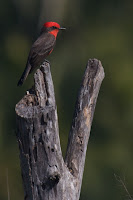Next week, I'll be guiding birding trips to supplement the trips of the San Blas bird festival. These trips are designed to sample all of the world-class birding San Blas offers, allowing a birder who goes on each to see over 250 species of birds and about two dozen Mexican endemics, rivaling the best of the professional tours of San Blas, at a fraction of the cost.
Tues., 25 Jan. Singayta 6:30 a.m. until noon $500 pesos ($50 US)
 |
| Mexican Parrotlets in Singayta |
This is the most famous, and oldest, birding site in San Blas, and with good reason. Birding along a road that runs between lowland jungle and mangrove swamps will give you an exceptionally birdy morning, full of San Blas specialties.
Wed., 26 Jan. Chacalilla and Playa del Rey 6:30 a.m. until noon $500 pesos
 |
| Vermilion Flycatcher at Chacalilla |
Get ready for the kind of morning only San Blas can offer. First, we’ll visit the Chacalilla, where scrub forests and fields combine with drying pools filled with water birds. Then we’ll cross the estuary to Playa del Rey (Peso Island) where thorn-forest birds meet shorebirds, and perhaps a Blue-footed Booby. We’ll never be farther than 10 minutes from town, and finish with well over 100 species for the morning.
Wed., 26 Jan. La Tovara 3:00 p.m. until 7:30 p.m. $500 pesos
 |
| Northern Potoo at La Tovara |
Another of the iconic San Blas experiences, this trip combines great birds with the most exotic boat ride you’ll find anywhere. We’ll return after dark to see night birds such as the Northern Potoo; this is the best place in the world to see this odd bird.
Thurs., 27 Jan. Mecatan and the “Big Fig” 6:00 a.m. until 1:00 p.m. $500 pesos
 |
| Gray Silky-Flycatcher at "the big fig" |
We’ll have some great birds today, perhaps including Elegant Quail, Purplish-backed Jay, Black-capped Gnatcatcher, and Red-breasted Chat as we bird the mixed habitats just inland from San Blas. We’ll also visit the legendary “big fig,” an enormous tree that can be full of birds such as the Gray Silky-Flycatcher.
Fri., 28 Jan. Cerro de San Juan 6:00 a.m. to 6:00 p.m. $650 pesos ($65 US)
 |
| Mexican Woodnymph on Cerro de San Juan |
In the pine-oak forests of Cerro de San Juan, birds entirely different from those near San Blas can be found. We’ll search for mixed flocks, hoping to see White-striped Woodcreeper, Crescent-chested Warbler, Rufous-capped Warbler, both Painted and Slate-throated Redstarts, Red-headed Tanager and many more. On our way home we’ll stop at Mirador del Aguila, where we can see spectaciular flights of Military Macaws.
Sat., 29 Jan. Tecuitata 6:00 a.m. until 2:00 p.m. $600 pesos ($60 US)
 |
| Scrub Euphonia at Tecuitata |
The shade-coffee plantation of Tecuitata is the hot new place for birding in San Blas. I’ve recorded over 170 species of birds there, including parrots, trogons, Colima Pygmy-Owl, San Blas Jay and many more. We’ll finish with a meal in the field prepared by the people of the village, for the incredible birding experience that’s the buzz of birders everywhere.
Sun., 30 Jan. Rio San Cristobal /Zooquilpa 6:00 a.m. until noon $600 pesos
 |
| Roseate Spoonbills and a Wood Stork over Rio San Cristobal |
We finish our week of the best of San Blas birdiing with another of the signature birding trips of these area – a pleasant, and very birdy boat ride up the San Cristobal River to the shallow lagoon at Zooquilpa. The morning high tide should give us access into the lagoon, thousands of whistling-ducks and a nesting colony of Roseate Spoonbills.
Questions and registration by phone at: (323) 285-1243 in Mexico or
(801) 518-5618 in the U.S.
or by e-mail at: mark@westwings.com
All transportation, land and water, is included. I will pick you up at your hotel or residence, within San Blas, or at a convenient point for those staying outside of San Blas. Each trip is limited to 7 people. Field breakfast, snacks, and water are provided. The Cerro de San Juan and Tecuitata trips include lunch as well. We will also have a spotting scope, audio equipment, a selection of field guides, and emergency supplies with us. You should bring appropriate clothing, insect repellent, sun protection, binoculars, a water bottle, and any personal items you need.
Advance register for all trips and receive a $400 Peso ($40 US) discount – act now, space is limited!

















